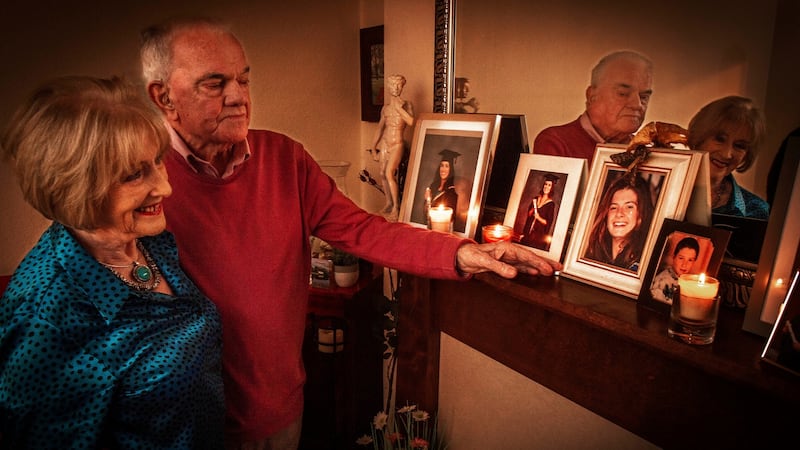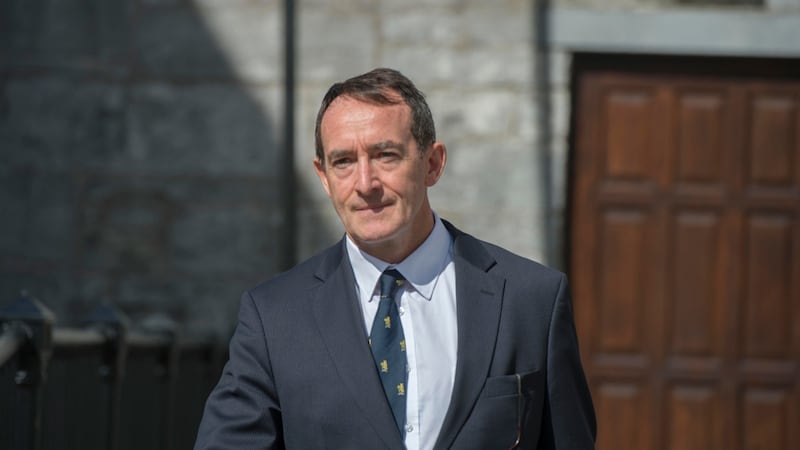“I’ve been lighting those nightlights every day for the last 20 years as if Yvonne was there – it’s my first job every morning when I get out of bed,” says Noel McCarthy, nodding towards the photo of the smiling young woman on the mantelpiece at the McCarthy home on the Well Road in Douglas.
"It would have been part of my recovery. [Cork singer] Ricky Lynch sang Bob Dylan's Forever Young at her funeral, and Yvonne is forever young – you never look at her as someone growing old. She was her own person and she loved life and it's like she's frozen now forever at 29."
It’s 20 years since Yvonne was killed in a car crash on the N20 near Rathduff, between Cork and Mallow, but the memory of that May bank holiday weekend in 2001 and the gardaí calling to the house has never left Noel and his wife, Patricia, as they recall in precise detail what happened.
I don't think I'll ever heal. You're able to deal with things better but it never goes away. Every morning she's the first thought in my mind
Patricia smiles as she remembers opening the door to find two gardaí on her doorstep and innocently thinking it might be over a parking fine that she had forgotten to pay and offering to go in to get her handbag before she quickly realised it was something far more serious.
“One of them said: ‘Are you Patricia McCarthy? We have some sad news,’ and he told me. It never leaves you – time is not a healer, all you can do is absorb it. I don’t think I’ll ever heal. You’re able to deal with things better but it never goes away. Every morning she’s the first thought in my mind.”
Noel and Patricia look tenderly at the photograph of Yvonne as they relate how they had to go to Cork University Hospital to identify her body, all the time frantic to know what had happened to her six-year-old son, Turloch, who was with her in the car at the time of the crash.

Turloch had serious but non-life-threatening injuries, including a broken arm and leg and some cuts. “It was terrible what happened but I often look at Turloch and think, ‘Thank God – he came out of it alive and wasn’t maimed,’” says Noel.
A medical anthropology student at NUI Maynooth, Yvonne was returning home to Cork for the May bank holiday weekend and had collected Turloch in Limerick. She was just half an hour from home when the crash happened just north of Rathduff at around 3.45pm on May 4th, 2001.
Noel tells how he used to drive out alone to Rathduff and stop at the spot and try to figure out what had happened. “There were no witnesses so I had a lot of unanswered questions and I stood on that point lots of times, looking at the cars and I remember thinking there wasn’t much room.”
The family erected a simple stone memorial at the spot where Yvonne was killed. Their son Roy tells how he remembers his sister every time he passes. “I drive the road regularly and it’s like every time I pass it, I sort of salute the stone. I’m very conscious of it and always will be, I think.”
Patricia says she could never go out to Rathduff, adding that every time she hears a radio report about another fatal crash on the N20, it brings the horror of it all back to her and she imagines what some other poor family must be going through.
“When I hear anything about crashes on the Mallow Road, my goodness, it’s unbelievable – I just shiver. I can’t think of anything else for a little while because it upsets me so much – it brings it all back straight away. To think of Yvonne there on the road and she was such a careful driver.”
While a handful may have occurred in unusual or atypical circumstances, the vast majority of fatalities came about during normal road usage
Yvonne McCarthy is one of at least 62 people to lose their lives on the Cork-Limerick road over the past 25 years, according to data compiled by The Irish Times from Garda press statements, media reports and memorials along the route to people killed in collisions.
Those killed include a variety of road users: car drivers, car passengers, truck and van drivers, motorcyclists, pedestrians and one cyclist. While a handful may have occurred in unusual or atypical circumstances, the vast majority of fatalities came about during normal road usage.
A number of accident blackspots along the N20 have been the scene of multiple fatalities over the years – Rathduff and Ballybeg and either side of Charleville in Co Cork and Banogue in Co Limerick being notable locations for loss of life.
In May this year, Transport Infrastructure Ireland (TII) published the results of an analysis of the N20. It concluded that road traffic collisions on the road were four times more likely to be fatal than on the average road in the country.
The TII analysis found that where nationally fatal road traffic collisions account for 2 per cent of all collisions in which personal injuries are recorded, the fatality rate for equivalent collisions on the N20 in which personal injuries are recorded was 8 per cent.
The TII analysis found that of the 87 collisions recorded on the N20 between 2016 and 2018, some seven of these involved the death of a road user and a further 13 collisions led to serious injuries, while the remaining 67 resulted in minor injuries to road users.
42 per cent of the road has no hard shoulder so there's nowhere to go if you need to try and take evasive action
Jari Howard, M20 project co-ordinator with Limerick City and County Council and the lead authority on the project, explained that the TII analysis also noted the high number of access points on the N20 road, comprising 216 entrances to fields, 295 to houses and 114 to public roads.
“There are a total of 625 access points onto the N20, or seven per kilometre, which is quite high compared to other national roads, so you have a lot of traffic exiting off and entering on to the road and that can be problematic, particularly for anyone turning right and crossing a lane of traffic.
“It’s also a classic example of a legacy road with different cross sections. There are sections of motorway, dual carriageway with hard shoulder, single carriageway through towns and villages. So it’s changing a lot, which is a particular challenge for anyone driving it the first time.

"You also have a situation where 42 per cent of the road has no hard shoulder so there's nowhere to go if you need to try and take evasive action. And there are really nasty spots on it like the Ballybeg bends outside Buttevant, which have been the scene of several fatalities.
“There’s a high volume of traffic with many doing high speeds, but then a lot of slow-moving vehicles like tractors and agricultural machinery as well as a lot of HGVs, which people try to overtake. So there are several factors making it dangerous.”
The introduction by Cork County Council in 2005 of a new "2+1" layout with a central barrier separating the two carriageways for 9km between Rathduff and Ballynamona between Cork and Mallow appears to have cut the number of fatalities on that section of the road.
The 2+1 layout has two lanes in one direction and one in the opposite direction and this pattern alternates approximately every 2km, so motorists driving in a two-lane section are separated from oncoming traffic by the central divide and can overtake safely.
According to Cork County Council, the 2+1 scheme was introduced to improve road safety at a time when 20 per cent of collisions, accounting for 37 per cent of fatalities, were head-on collisions and a further 24 per cent of collisions, accounting for 30 per cent of fatalities, were single-vehicle collisions.
The N20 was one of three roads nationally on which the 2+1 layout was introduced on a pilot basis. But in 2007 the National Roads Authority (precursor to TII) decided against using a 2+1 road design for an upgrade of more than 850km of national roads, so there was no further extension of the 2+1 along the N20.
While Howard has no doubt about the need to upgrade the entire road from a safety point of view, there is a lot of local opposition to some of the proposed routes, while the Cork-Limerick Alliance Group (CLAG), representing some 1,500 landowners, has argued against a major upgrade.
Last month, CLAG chairman Brian Hyde told The Irish Times the group believed the better solution would be for the TII to build a motorway from Limerick to Cahir, where it could link up with the existing N8 Cork-Dublin motorway. He questioned the need for an M20 motorway.
When you are designing a road, you just don't count the traffic end to end, you count all the intermediate stages as well
Hyde said that TII’s own figures show that just 3,000 vehicles a day travel between Cork and Limerick, with a projected rise to 4,000 to 6,000 a day by 2030, which amounted to just 7 per cent of the proposed capacity of 57,000 vehicles a day at a cost of between €2 billion and €3 billion.
"Yes, the N20 needs to be upgraded by bypassing Buttevant and Charleville and realigning the road where necessary, but the traffic flows don't justify spending €2-€3 billion," he said, adding that a motorway will lead to a bottleneck in Blackpool as there is no northern ring road around Cork city.
Howard disagrees, however, saying the road planning is not based on end-to-end travel – in this case Cork to Limerick – but rather on those using any portion of the road, as happens on all motorways including the N8 Cork-Dublin and N7 Limerick-Dublin routes.
“When you are designing a road, you just don’t count the traffic end to end, you count all the intermediate stages as well. So while there may be 3,000 to 5,000 vehicles a day from Limerick making the full journey to Cork, you have much higher volumes on other sections.
“We get around 17,000 vehicles coming into Limerick at the northern end. It starts to drop down gradually then towards Charleville and Buttevant, to around 13,000 a day. But then it ramps up to 17,000 or 18,000 around Mallow and from Blarney into Cork then it’s up to around 25,000 a day.
“And what is more significant is that some sections are just over capacity – sections where you have no hard shoulders and a lot of junctions and accesses. Even at the middle section, where volume is lowest, 13,000, that’s still 5,000 over capacity and in some places it’s far worse than that.
“And it’s in the places where there is overcapacity, that’s where your safety risk is higher. People turning right to enter onto the road are struggling to get across the lane of traffic – they are stressed, so they’ll take a chance and that’s when accidents happen. Overcapacity reduces safety.”

One person with an intimate knowledge of just how dangerous the existing road can be is Buttevant GP Dr Michael Kennedy, who not only came upon one accident near Ballybeg where a young man lost his life but, in his role as coroner for north Cork, has dealt with many fatal collisions.
“The road hasn’t changed in maybe 50 years, and in my 20 years or more as coroner we’ve had a lot of fatalities – many of them in blackspots like Ballybeg, just south of Buttevant, where you have a huge volume of traffic, some of it travelling at speed, going through twisty bends with poor visibility.
“We’ve had a few north of Buttevant as well, but again that’s the road going from a fine, wide road into a narrow road and we’ve had pedestrian fatalities in Buttevant and Charleville. If both towns were bypassed and HGVs were diverted out of the towns, that would improve the situation.”
According to Jari Howard, a motorway is five times safer than a legacy road such as the N20, and the most recent statistics from the Road Safety Authority for the period 2018-20 confirm that motorways and rural dual carriageways are far safer than rural two-lane roads.
Ultimately, when and what gets to replace the existing N20 roadway is a political decision
Motorways have an overall average collision rate of 1.66 per 100 million km of travel and rural dual carriageways have an average collision rate of 2.372 per 100 million km of travel. Whereas rural two-lane roads have an average collision rate of 6.797 per 100 million km of travel.
The RSA statistics also show that of the 134 who died on Irish roads in 2018, the last year for which official figures are available, nine died in collisions on motorways, six died on dual carriageways, four died on one-way single carriageways – and 111 died on two-way single carriageways.
Ultimately, when and what gets to replace the existing N20 roadway is a political decision. Plans to upgrade the road have a long history going back at least to 1999, when the Fianna Fáil/Progressive Democrats coalition included it as part of a €4.7 billion roads upgrade package.
Since then the road came closest to an upgrade in the late 2000s when the National Roads Authority applied for planning permission for a selected route. But then minister for transport Leo Varadkar shelved the project in 2011 as the economic crash hit government coffers.

The project, which back in 2011 was estimated to cost €850 million, has remained effectively frozen for the past decade, and while it was included in the recent National Development Plan (NDP) launched in Cork last month, its future remains shrouded in uncertainty.
Minister for Transport Eamon Ryan, in keeping with Green Party policy favouring public transport ahead of building motorways, has sounded a cautious note about upgrading the road to a motorway while acknowledging that there are serious safety issues with the existing roadway.
“Yes, safety first. But we have to be careful and that’s why we are looking at all options and ruling no options out,” said Ryan when asked about the high fatality rate on the N20 at a press briefing in Cork prior to the launch of the NDP on October 4th.
The Minister went on to say that he didn’t expect all the projects listed in the NDP would be delivered, as funding was finite and the Government had already given commitments to deliver on a number of these, so there was no guarantee there would be funding available for Cork-Limerick.
“The estimate now is that if we were to do it to full motorway status, it could be about €3 billion and we need to look at that in the limited budget situation we are in,” he said.
Since then Ryan has been quizzed closely by public representatives from Cork and Limerick at the Oireachtas joint Committee on Transport and Communications. The chairman, Fine Gael Limerick City TD Kieran O’Donnell, last week pressed the Minister on his €3 billion estimate for the work.
O’Donnell said he had spoken to officials in TII who confirmed the cost would likely be closer to €1.4 billion (based on €10 million per kilometre – rising at most to €15 million per kilometre – for 90km of road). The higher estimate of €3 billion may have arisen because during a review of the NDP the cost option categories were ones less than €1 billion or €1 billion-€3 billion, and it technically fell into the latter.
Howard believes the project can be delivered in a way that meets with the aims of Eamon Ryan, who has spoken favourably of bypassing towns and villages to make them more sustainable for their residents, by focusing initially on bypassing towns like Charleville, Buttevant and Mallow.
“Minister Ryan is very keen on bypasses – now you could have several contracts running together or maybe one or two going ahead first. If you were to do the two bypasses first, they may not have the highest volumes of traffic but they would have the greatest impact for road users and residents.
“They would reduce congestion while at the same time improving safety considerably by taking out some of the worst sections of the road.”
As a coroner holding inquests into all these deaths, all you can do is make your recommendations and hope somebody is listening
Howard says he is confident from a TII analysis of collisions that an upgrade to the motorway and dual carriageway will save approximately 60 lives over the next 30 years.
“If you have a higher-end solution with a dual carriageway the whole length of the scheme, you are looking at saving 1,500 collisions, 150 serious injury collisions and about 60 fatal collisions – there will still be collisions and still be deaths, but 60 lives will be spared and 150 lives not destroyed.”
Dr Kennedy has seen the number of deaths reduce significantly on the M8 Cork-Dublin route (where his coronial jurisdiction extends to Mitchelstown) since it was upgraded to a motorway. He believes a similar upgrade of the N20 is something that should happen sooner rather than later.
“It can be a bit despondent when you are looking at accidents at the same place, year after year but, as a coroner holding inquests into all these deaths, all you can do is make your recommendations and hope somebody is listening,” he says.
“I can see all the arguments that people are putting forward that the road may be underutilised [if upgraded to a motorway] and that kind of thing, but when you look at all the deaths that we are having on the road, if it alleviates only one or two deaths, then surely it must be worthwhile.”
Noel McCarthy echoes this sentiment: “If you saved only one life, surely it would be worthwhile.”
Patricia McCarthy is even more direct: “I think it would have a made a difference to Yvonne. It’s a treacherous road and for it to have been left like this, for all these years with the amount of people, young and old, that have been killed on it, it’s just a disgrace.”




















